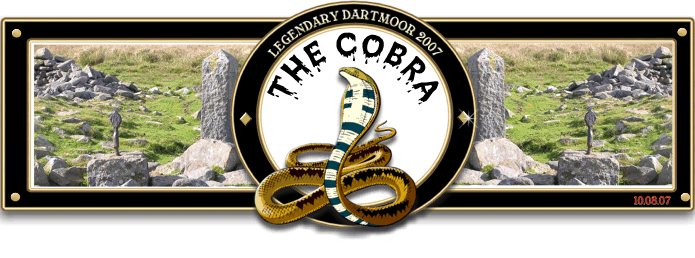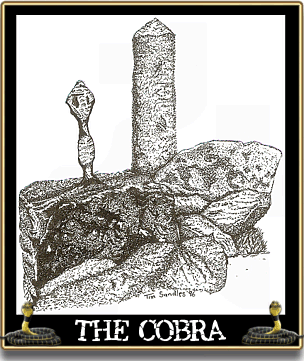
A cobra slithering around on Dartmoor? Is this an effect of global warming? In fact at one time there were 4 cobras to be found on Dartmoor, however today there is only one perfect specimen to be found. But there is no need to worry this particular ‘Cobra’ is perfectly harmless and it hasn’t bitten anyone to the best of my knowledge. It sits quietly embedded in a rock between 2 cairns on the top of Eylesbarrow from where it has some splendid views of the moor and over to Cornwall. Ok, so forget the drama, what is it? The cobra is simply an iron bar with a flattened head upon which is inscribed ‘FB’ (Forest Bounds) that has been set into a square granite boulder. Originally the head had ‘WB’ inscribed on the western face but corrosion caused by the prevailing westerly weather has completely obliterated all traces of the letters. Its purpose is to mark a point on the bounds of the Forest of Dartmoor and the old manor of Walkhampton but the actual hilltop on which it stands could arguably mark much older lands.
Depending on one’s theory as to the purpose of Bronze Age cairns it could be said that the first use of this prominence was to define some tribal lands by way of interring the dead under piles of rock which acted as boundary markers. Over the centuries the actual place-name has taken on various forms; Elysburghe, Elisboroughe, Elesburghe, Gyllesburgh, Ailsborough, Eylesborough and now the modern Eylesbarrow. The second element to all the names (burghe, borough and barrow) all refer to the larger of the two cairns which sit on the summit of the hill (sometimes referred to as Eylesbarrow tor). Eylesbarrow is first documented in the bounds of the 1240 perambulation where it is stated: “et inde linealiter usque ad Elysburghe“, in the 1609 perambulation the spelling had changed slightly to: “Elisboroughe“.
In the 13th century Amicia, Countess of Devon held three manors; Buckland Monachorum, Bickleigh and Walkhampton, these lands she gave to the Cistercians to found an abbey at Buckland Monachorum. The countess died in 1291 and a deed of that time listed the bounds of her lands and here they state that the line runs: “by Siward’s Cross and Gyllesburgh and Plymcrundla to the Plym…“. so here again we see Eylesbarrow in the form of Gyllesburgh. So not only do we have Eylesbarrow acting as a bound of the Forest of Dartmoor it now serves as a marker for the lands of Buckland Abbey which include the old manors previously noted. We now have to jump forward some 500 odd years to 1867 to finally meet ‘The Cobra’, at this time the manor of Walkhampton had moved on to the ownership of Sir Massey Lopes who enters into a dispute with the Duchy regarding the Forest bounds. In a Deed of Agreement dated the 10th of August 1867 the agreed boundary was:
“From Deadlake Foot in a straight line to the summit of Great Mis Tor to be marked by an iron cross; thence in a straight line to North Hessary Tor (iron cross); thence similarly to South Hessary Tor (iron cross); thence similarly to Nun’s Cross; thence similarly to Eylesborough (iron cross)” (Brewer 2002 pp. 156 -7).

© Tim Sandles 2007
So there is the proof that at one time there were four ‘Cobras’ on Dartmoor, located on Great Mis Tor (now has a military flagpole over it), North Hessary Tor (now covered by an ordnance survey trig pillar) , South Hessary Tor and on Eylesbarrow. The first two have long vanished leaving just the ones on South Hessary and Eylesbarrow although sometime in summer of 2006 vandals broke off the one on South Hessary Tor. Luckily it was discovered bent and lying by its original location and was handed into the National Park Authority who are deciding if it can be replaced or if a replica needs to be made. This then leaves the Eylesbarrow Cobra as the last of its kind out on the moor although that too has received some remedial work. In 1991 the iron bar was found to be sitting loosely in its socket and so it was removed by the National Park Authority and securely fixed into a new stone which now stands in the original position of its predecessor. In 2014 the ‘Cobra’ was completely vandalised and was decapitated and the head stolen. In the February of 2015 a replica ‘Cobra’ was made at the Princetown forge with the aim of placing in the original location on Eylesbarrow. The completed replica was relocated on the 25th of March 2015 with the cost of the work being shared by The Duchy of Cornwall and the Dartmoor National Park Authority.
Eylesbarrow also served as one of the eastern boundary points of the nearby Ditsworthy Rabbit Warren as well as sitting on the northern bounds of the old 1814 Ellisborough tin mine. As if all these boundaries were not enough there is one final boundary for which Eylesborough sits upon and that is the catchments area that encompasses the Burrator reservoir. In 1916 the lands covering the dam’s catchments were purchased and in 1917 a series of boundstones were erected to mark the extent of the land, each one was inscribed with the letters ‘PCWW’ (Plymouth Corporation Water Works). An example of these boundstones stands a few feet away from ‘The Cobra’ and when approaching the hill from the east both markers become visible between the two cairns. Occasionally it is possible to hear mention of another name for the iron bar and that is the ‘Excalibur’ and this applies also to the one that was on South Hessary. The reasoning for this is pretty obvious although there is no record of a re-incarnated Arthur drawing it from the stone, well maybe he just hasn’t come yet.
If you are looking for a short walk on Dartmoor then pick a clear day and have a stroll up to Eylesborough, there are some splendid views, usually a herd or two of Dartmoor ponies and of course ‘The Cobra’.
 Legendary Dartmoor The many aspects past and present of Dartmoor
Legendary Dartmoor The many aspects past and present of Dartmoor
